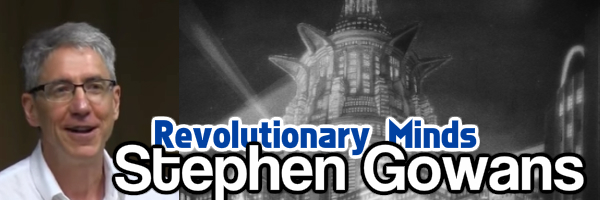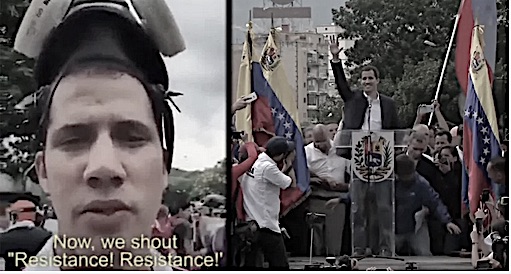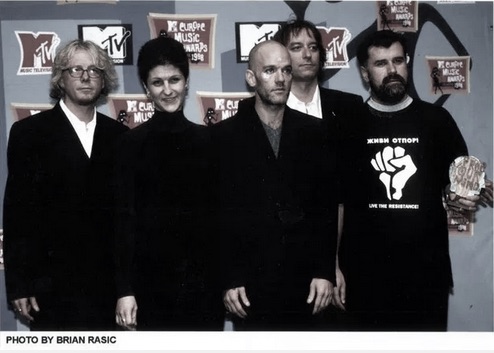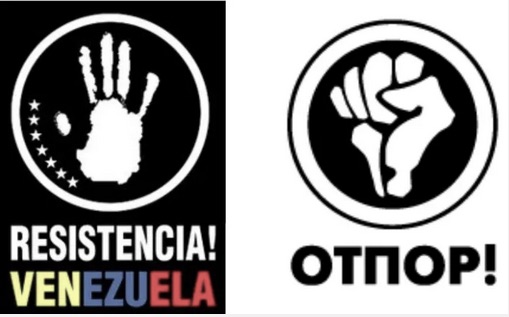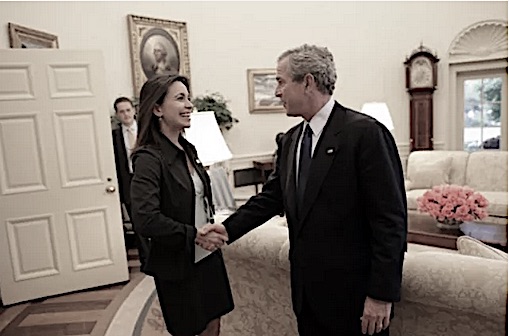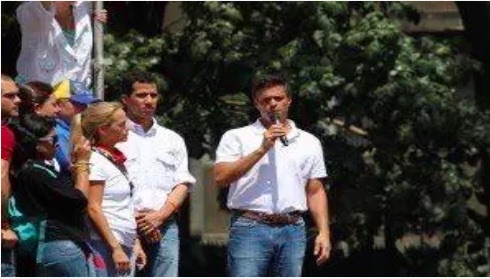The growing hostility of Western governments to China is more about the interests of Western investors than legitimate security fears
First iteration December 30, 2018 • Reposted on Feb. 7, 2019

Chopper taking off from US carrier operating in South China sea.
[dropcap]T[/dropcap]he United States stations 320,000 troops in the vicinity of China [1], maintains a continuous B-52 bomber presence in the region, including over waters claimed by the East Asian giant, [2] and has sent its “most advanced warfighting platforms to the region, including multi-mission ballistic missile defense-capable ships, submarines, and intelligence, surveillance and reconnaissance aircraft.” [3] The 2018 US National Defense Strategy lists China first among the United States’s “five central external threats” including “Russia, North Korea, Iran, and terrorist groups with global reach.” [4] The secretary of state, Mike Pompeo, has called China the “great threat for the U.S. in the long term.” [5] According to The Washington Post’s Bob Woodward, the Trump administration considers China “the real enemy.” [6]
What has China done to make successive US administrations see it as a major external threat and the real enemy? The answer is that China has developed a state-led economic model that limits the profit-making opportunities of US investors and challenges their control of high-technology sectors, including artificial intelligence (AI) and robotics, essential to US military supremacy. Washington is engaged in a multi-faceted war “to prevent Beijing from advancing with plans … to become a global leader in 10 broad areas of technology, including information technology, aerospace and electric vehicles.” [7] Washington aims to “hobble China’s plans to develop advanced technology” [8] and to “force China to allow American companies to sell their goods and operate freely” in China, under conditions conducive to maintaining US economic and military supremacy. [9]
For its part, China seeks to alter a global economic system in which it is allowed only “to produce T-shirts” while the United States produces high-tech, according to Yang Weimin, a senior economic adviser to China’s president Xi Jinping. [10] Xi is “determined that China master its own microchips, operating systems and other core technologies” [11] in order to become “technologically self-reliant.” [12] But self-reliance in industries like aerospace, telecommunications, robotics, and AI means removing China, a large market, from the ambit of US high-tech firms. [13] Moreover, since Western military supremacy has always relied on Western technological superiority, Chinese efforts to challenge the Western monopoly on high-tech translates directly into an effort to challenge Washington’s ability to use the Pentagon as an instrument for obtaining investment and trade advantages for US investors.
China’s economic model
[dropcap]C[/dropcap]hina’s economic model is often called “state capitalist” or “market socialist.” Both terms refer to two important elements of the Chinese model: the presence of markets, for materials, products and labor, and a role for the state, through industrial planning and ownership of enterprises. [14]
The “mainstay of the economy” [15] is China’s over 100,000 state owned enterprises. [16] The state has a strong presence in the commanding heights of the economy. “Key sectors such as banking are…dominated by state-controlled companies.” [17] State-owned enterprises “account for about 96% of China’s telecom industry, 92% of power and 74% of autos.” [18] Beijing “is the biggest shareholder in the country’s 150 biggest companies.” [19] The combined profit of state-owned “China Petroleum & Chemical and China Mobile in 2009 alone was greater than all the profit of China’s 500 largest private firms.” [20]
Industrial planning is carried out by the National Development and Reform Commission. The commission uses various means to incubate Chinese industry in key sectors [21] and drafts plans “to give preferential treatment” to Chinese firms in strategic areas. [22]
 Beijing is counting on state owned firms “to become global leaders in semiconductors, electric vehicles, robotics and other high-technology sectors and is funding them through subsidies and financing from state banks.” [23] The planning commission also guides the development of steel, photovoltaics, high-speed trains, and other critical industries. [24]
Beijing is counting on state owned firms “to become global leaders in semiconductors, electric vehicles, robotics and other high-technology sectors and is funding them through subsidies and financing from state banks.” [23] The planning commission also guides the development of steel, photovoltaics, high-speed trains, and other critical industries. [24]
Beijing has closed sectors it considers strategic or vital to national security to foreign ownership. These include “finance, defense, energy, telecommunications, railways and ports” [25] as well as steel. All steel industry firms are state-owned and all are financed by state-owned banks. [26] In total, “China … has restricted or closed off 63 sectors of its own economy to foreign investors, such as stem-cell research, satellites, exploration and exploitation of numerous minerals and media, as well as humanities and social-sciences research institutes.” [27]China also relies heavily on joint venture arrangements to acquire Western technology and know-how. This idea was initially introduced to China by General Motors, which proposed a joint venture in 1978 with the Chinese car industry. GM’s idea was to trade off its technology and know-how for access to a vast market and low-wage labor. [28]
Chinese leaders saw joint ventures as a way “to propel its industries up the value chain into more sophisticated sectors and the country into rich-nation ranks.” [29] Technology acquired from Western partnerships diffused into the Chinese economy, allowing Chinese firms to become competitors of the Western companies. [30] For example, Chinese rail companies used technology acquired through joint ventures with Japanese and European firms to become giants in high-speed rail. [31]
China seeks to achieve self-sufficiency in high-tech by 2025 under a plan called Made in China 2025. The idea is to vault into the top ranks of high-tech, matching and eventually overtaking the West. Xi has complained that Chinese “technology still generally lags that of developed countries” and that China must “catch up and overtake” the West in “core technological fields.” [32] To help achieve this goal, Beijing plans to “spend billions in the coming years to make the country the world’s leader in A.I,” [33] among other areas.
China’s economic model is not new. According to the economist, Chang Ha-joon:
“In a way, what it is doing is actually not that different from what the more advanced countries were doing in the late 19th century and early 20th century. Many countries, including Japan and Germany, like China today, were using state-owned enterprises to develop their strategic industries. You can say that China is going through what all the other economically advanced countries have been through, and examples range from the U.S. in the mid-19th century to South Korea in the 1970s and 80s.”[34]
US objections
[dropcap]C[/dropcap]ountries which dominated the globe economically, politically, and militarily have always been the great champions of free trade. The United States had no use for free trade until it became the dominant economic power in the wake of the Second World War. Until the end of WWII, US tariffs were among the world’s highest. Emerging from the war as the planet’s strongest economic power, the United States did all it could to impose free trade, free markets and US free enterprise on as much of the world as it could, and wasn’t shy about using economic warfare, the CIA, and military force to accomplish its goal.

More than 400 American military bases encircle China with missiles, bombers, warships and nuclear weapons. Charles Gatward: The Coming War on China, Dartmouth Films
Today, Washington objects strenuously to the Chinese economic model, to the point that it’s willing to use economic warfare, military intimidation, and perhaps even outright war (see below) to impede it. Access to Chinese markets and low-wage labor is highly valued by the US state, but Washington resents access being made contingent on joint venture arrangements which allow US technology to be absorbed by Chinese businesses. The United States demands that US investors be freed from such conditions, that US corporations be granted unfettered access to all Chinese markets, and that US firms be allowed to compete with Chinese enterprises on equal terms, without favor for Chinese companies. There are two reasons Washington makes these demands: to maximize the profit-making opportunities available to US investors in China and to prevent Beijing from building ‘national champions’ able to compete with US corporations. [35]
The US economic elite has for years expressed its grievances over China’s state owned enterprises. It complains that it is “denied lucrative government business, which goes instead to the state champions.” [36] US business people grouse that “In the past few years, China has significantly increased the government’s role in the economy, pumping up the state sector and crowding out private and foreign businesses.” [37] And they lament that the “heavily protected and subsidized Chinese state-owned enterprises … are pounding U.S. companies not just in China but in competition globally.” [38] In response to these grievances, Washington is pushing for “reducing the role of state-owned firms in China’s economy.” [39]Made in China 2025 is a significant irritant to Washington. Peter Navarro, US president Donald Trump’s trade adviser, denounces it as “economic aggression” because it “threatens the U.S. technology sector.” [40] US vice-president Mike Pence calls it Beijing’s master plan to bring “90% of the world’s most advanced industries” under the control of the Chinese Communist Party. [41] An emblematic US media description of the Chinese plan is: “Made in China 2025 is Beijing’s plan to dominate global markets in a wide range of high-tech products. China’s strategy is to give large government subsidies to state-owned companies and supplement their research with technology” acquired from Chinese partnerships with, or purchase of, US firms. [42] The description contains within it a diagnosis and implied US treatment plan: Compel Beijing to a) end subsidies to state-owned enterprises; b) lift joint venture conditions which allow Chinese firms to acquire US technology; and c) prevent Chinese companies from buying Western firms as a means of acquiring Western technology.
China Rising: Capitalist Roads, Socialist Destinations
Windows into China's real history and everyday life

Three invaluable and engaging books to better understand this complex and embattled civilisation already dominating our century. Written by our own China expert (and associate editor) Oklahoma born Jeff J. Brown, who has lived in China for many years. Click here for more details.
The New York Times has reported that the US trade representative Robert Lighthizer “wants China to reduce subsidies and other aid to Chinese firms competing internationally in advanced technology” [43] and that one US “demand is for China to halt its subsidies for its ‘Made in China 2025’ program aimed at giving its companies a foothold in aircraft, robotics and other areas of advanced manufacturing.” [44]
“Beijing believes in state-driven research to help state-owned industries,” observes The Wall Street Journal, “while the U.S. depends on the private sector, along with a healthy dose of government-funded basic research.” [45] That’s not entirely true. The privately-owned Chinese telecom equipment maker, Huawei, spent “$13 billion last year … developing its own technologies, outpacing Intel Corp. and spending almost as much as Google parent Alphabet Inc.” [46] And corporate America’s reliance on government-funded R&D is far greater than usually acknowledged.
[dropcap]W[/dropcap]ashington started investing heavily in R&D after the allegedly innovation-stifling Soviet economy allowed the USSR to beat the United States into space, and then chalk up a series of other firsts: the first animal in orbit, first human in orbit, first woman in orbit, first spacewalk, first moon impact, first image of the far side of the moon, first unmanned lunar soft landing, first space rover, first space station and first interplanetary probe. Beat by the Russians, the United States was galvanized to take a leaf from the Soviet book. Just as the Soviets were doing, Washington would use public funds to power research into innovations. This would be done through the Defense Advanced Research Projects Agency. The DARPA would channel public money to scientists and engineers for military, space and other research. Many of the innovations to come out of the DARPA pipeline would eventually make their way to private investors, who would use them for private profit. [47] [a]lgorithms that underpinned Google’s success were funded by the public sector. The technology in the Apple iPhone was invented in the public sector. In both the US and Britain it was the state, not big pharma, that funded most groundbreaking ‘new molecular entity’ drugs, with the private sector then developing slight variations. And in Finland, it was the public sector that funded the early development of Nokia – and made a return on its investment. [49]
Nuclear power, satellite and rocket technology, the internet and self-driving cars are other examples of innovations that were produced with public money, and have since been used for private profit. When he was US president, Barack Obama acknowledged the nature of the swindle in his 2011 State of the Nation Address. “Our free-enterprise system,” began the president, “is what drives innovation.” However, he immediately contradicted himself by saying, “But because it’s not always profitable for companies to invest in basic research, throughout history our government has provided cutting-edge scientists and inventors with the support that they need.”
Today, the United States “is spending roughly $1 billion to $2 billion annually, much of it federal funds, to build the first ‘exascale’ supercomputer—capable of a quintillion calculations a second, which is at least 100 times faster than today’s champion. Such a machine would help in everything from designing futuristic weapons to investigating brain science.” [50] The US government is also “boosting spending in semiconductor research, an area of intense Chinese interest.” [51] Meanwhile, the White House’s Office of Science and Technology Policy is funding research on “quantum mechanics to eventually make computers and communications operate at speeds and efficiency well beyond anything possible today.” [52] And on top of these public R&D expenditures, the DARPA continues to fund advanced research, including on A.I. [53] Simultaneously, Washington is demanding that China halt its own R&D spending in the same areas.
All of this points to a number of important facts. (1) The United States kick-started innovation in its own economy by emulating the Soviet model of state-directed research because free enterprise was not up to the task. (2) Rather than emulate the Soviet model for public benefit, the United States channels public money into R&D for private profit. (3) US high technology supremacy relies significantly on public funding, yet (or rather because of this) Washington demands that China forbear from its own public funding of innovation research. Washington will only tolerate public funding of basic research that benefits US investors.
Explaining US hostility to China
[dropcap]U[/dropcap]nderstanding the economic and political organization of the United States helps understand why Washington is antagonistic to China’s economic model. The following explains the US political elite’s hostility, currently expressed in the declaration of China as the United States’ top external threat; in the US-instigated trade war against China; in the blocking of Chinese purchases of US companies; and in the exclusion of, or threat to exclude, such Chinese corporations as Huawei and ZTE from Western markets.
The US political elite is interlocked with the community of major US investors. US administrations, the US senate, and the top strata of the US bureaucracy, are mainly staffed by wealthy individuals whose wealth derives from investment income. Additionally, organized business groups and major corporations exert significant influence on the political elite through lobbying, via the funding of policy formation think-tanks, and by ownership of the mass media. In their 2014 study of over 1,700 US policy issues, the political scientists Martin Gilens and Benjamin I. Page demonstrated that “economic elites and organized groups representing business interests have substantial impacts on government policy, while average citizens and mass-based interest groups have little or no independent influence.” [54] Accordingly, US foreign policy defines external threats as threats to the interests of US “economic elites and organized groups representing business interests”—the very same community which dominates the formulation of public policy.The US National Defense Strategy does not define China as a threat to the United States but as threat to US interests. Unlike the United States, which has a significant military presence in the air, sea and land around China, the East Asian giant does not have a military presence in the Western hemisphere, and is not currently capable of projecting force into it. China does not therefore constitute a military threat to the United States. What, then, are the US interests that China’s threatens? Consistent with the interlocked nature of the US political and economic elites, US interests refer to the profit-making interests of US investors.
China’s economic model threatens the profit-making interests of US economic elites and organized business groups in the following ways.
• State-owned enterprises are closed to US investors and compete against US investment.
• Protected sectors deny US investors profit-making opportunities.
• Joint venture requirements limit US investment and are used to acquire technology to develop enterprises which become capable of competing with US firms.
• State incubation of national champions develops competitors to US investment.
• Made in China 2025 locks US investment out of Chinese high-tech markets, competes against US high-tech investment globally, allows China to contest US military supremacy, and undermines US capabilities to use force to obtain trade and investment opportunities under favorable conditions.
China’s economic model also threatens US (investor) interests by offering an exemplar for other countries to follow, which, if followed, would reduce US profit-making opportunities even more significantly. The Chinese model has had undoubted success in lifting China from poverty. In 1984, three-quarters of the Chinese population still lived in extreme poverty. By 2018, extreme poverty had fallen to less than one percent. [55] And China is poised to challenge the West’s technological supremacy. These extraordinary accomplishments were not the product of Beijing following Washington’s economic advice; they are “due to planning in a socialist market, not conventional capitalism,” observes Robert C. Allen, a specialist in economic development. [55] Even The Wall Street Journal acknowledges that China’s “rapid economic development” is due to “state enterprises operating under an industrial plan.” [57] Washington cannot allow such a model to take hold and spread, for if it does, the profit-making opportunities on which US investors depend will shrink. US free enterprise, from Washington’s point of view, must be welcomed everywhere—and the division of the world between exploiting countries and exploited ones must continue ad infinitum.
Time and again, underdeveloped countries have implemented economic models at the core of which have been state-owned enterprises and industrial planning. In almost every case, Washington has used sanctions, the CIA, or the Pentagon, or all three, to put a stop to this threat to the profit-making interests of the United States’s ‘substantial’ citizens. Today, the US elite is agreed that China must be ‘contained’, even if there is no agreement on how. The think-tank, the RAND Corporation, funded by the US government, US corporations, and US investors, has even contemplated open war as a solution, in a 2016 study titled War with China: Thinking Through the Unthinkable. [58]
The words of Norman Bethune, a Canadian surgeon who served in Mao’s Eighth Route Army, come to mind.
“Behind all stands that terrible, implacable God of Business and Blood, whose name is Profit. Money, like an insatiable Molloch, demands its interest, its return, and will stop at nothing, not even the murder of millions, to satisfy its greed. Behind the army stands the militarists. Behind the militarists stands finance capital, and the capitalists. Brothers in blood; companions in crime.” [59]
NOTES
1. Elisabeth Bumiller, “Words and deeds show focus of the American military on Asia”, The New York Times, September 10, 2012.
2. Jeremy Page and Gordon Lubold, “U.S. bomber flies over waters claimed by China,” The Wall Street Journal, December 18, 2015.
3. Trefor Moss and Jeremy Page, “U.S. stationing warplanes in Philippines amid South China Sea tensions,” The Wall Street Journal, April 15, 2016.
4. National Defense Strategy, 2018, https://fas.org/sgp/crs/natsec/IN10855.pdf.
5. Steven Erlanger, “Tillerson’s ouster has allies hoping for coherence, but fearing the worst,” The New York Times, March 14, 2018.
6. Bob Woodward. Fear: Trump in the White House, (Simon & Schuster, 2018), 298.
7. Bob Davis, “Trade rift within Trump administration sends stocks on wild ride,” The Wall Street Journal, June 25, 2018.
8. Bob Davis, Vivian Salama and Lingling Wei, “China issues retaliatory tariffs as trade fight heats up,” The Wall Street Journal, June 15, 2018.
9. Neil Irwin, “The Trump trade strategy is coming into focus. That doesn’t necessarily mean it will work.” The New York Times, October 6, 2018.
10. Lingling Wei, “US and China dive in for prolonged trade talks,” The Wall Street Journal, May 3, 2018.
11. Chris Buckley and Paul Mozur, “What keeps Xi Jinping awake at night,” The New York Times, May 11, 2018.
12. Ibid.
13. Adam Segal, “Why does everyone hate Made in China 2025?” Council on Foreign Relations blog, March 28, 2018.
14. Robert C. Allen, The Industrial Revolution: A Very Short Introduction. (Oxford University Press, 2017), 126.
15. James T. Areddy, “Xi Jinping aims to rebrand China—as an importer,” The Wall Street Journal, November 5, 2018.
16. New York Times, June 3, 2009.
17. The Globe and Mail, October 17, 2008.
18. John Bussey, “Tackling the many dangers of China’s state capitalism”, The Wall Street Journal, September 27, 2012.
19. “The rise of state capitalism”, The Economist, January 21, 2012.
20. Bussey, September 27, 2012.
21. Allen, 126.
22. Michael Wines, “China takes a loss to get ahead in the business of fresh water”, The New York Times, October 25, 2011.
23. Bob Davis, “When the world opened the gates of China,” The Wall Street Journal, July 27, 2019.
24. Allen, 127.
25. Michael Wines, “China fortifies state businesses to fuel growth”, The New York Times, August 29, 2010.
26. Allen, 126.
27. Steven Chase and Robert Fife, “CSIS report warns of Chinese interference in New Zealand,” The Globe and Mail, May 30, 2018.
28. Lingling Wei and Bob Davis, “How China systematically pries technology from US companies,” The Wall Street Journal, September 26, 2018.
29. Ibid.
30. Ibid.
31. Carlos Tejada, “Beg, borrow or steal: How Trump says China takes technology,” The New York Times, March 22, 2018.
32. Chris Buckley and Paul Mozur, “What keeps Xi Jinping awake at night,” The New York Times, May 11, 2018.
33. Cade Metz, “Mark Zuckerberg, Elon Musk and the feud over killer robots,” the New York Times, June 9, 2018.
34. Seung-yoon Lee, “Ha-Joon Chang: Economics Is A Political Argument,” World Post, June 4, 2014.
35. Yoko Kubota, “Trade war punctures China’s price in its technology,’ The Wall Street Journal, June 28, 2018.
36. John Bussey, “Tackling the many dangers of China’s state capitalism”, The Wall Street Journal, September 27, 2012.
37. Lingling Wei and Bob Davis, “China prepares policy to increase access for foreign companies,” The Wall Street Journal, December 12, 2018.
38. John Bussey, “U.S. attacks China Inc.”, The Wall Street Journal, February 3, 2012.
39. Bob Davis, “US tariffs on China aren’t a short-term strategy,” The Wall Street Journal, October 6, 2018.
40. Michael C. Bender, Gordon Lubold, Kate O’Keeffe and Jeremy Page, “US edges toward new Cold-War era with China,” The Wall Street Journal, October 12, 2019.
41. Martin Feldstein, “Tariffs should target Chinese lawlessness, not the trade deficit,” the Wall Street Journal, December 27, 2018.
42. Ibid.
43. Bob Davis, Peter Nicholas and Lingling Wei, “”Get moving’: How Trump ratcheted up the trade battle with China,” The New York Times, June 7, 2018.
44. Neil Irwin, “The Trump trade strategy is coming into focus. That doesn’t necessarily mean it will work.” The New York Times, October 6, 2018.
45. Bob Davis, “The country’s R&D agenda could use a shake-up, scientists say,” The Wall Street Journal, December 22, 2018.
46. Dan Strumpf, Min Jung Kim and Yifan Wang, “How Huawei took over the world,” The Wall Street Journal, December 25, 2018.
47. Mariana Mazzucato, The Entrepreneurial State, Demos, 2011,
http://www.demos.co.uk/files/Entrepreneurial_State_-_web.pdf?1310116014).
48. Fred Block and Matthew R. Keller, “Where do innovations come from? Transformations in the U.S. national innovation system, 1970-2006,” Technology and Innovation Foundation, July 2008.
http://www.itif.org/files/Where_do_innovations_come_from.pdf
49. Seumas Milne, “Budget 2012: George Osborne is stuck in a failed economic model, circa 1979,” The Guardian (UK), March 20, 2012.
50. Bob Davis, “The country’s R&D agenda could use a shake-up, scientists say,” The Wall Street Journal, December 22, 2018.
51. Ibid.
52. Ibid.
53. Ibid.
54. Martin Gilens and Benjamin I. Page, “Testing Theories of American Politics: Elites, Interest Groups, and Average Citizens,” Perspectives on Politics, Fall 2014.
55. Phillip P. Pan, “The West was sure the Chinese approach would not work. It just had to wait. It’s still waiting.” The New York Times, November 18, 2018.
56. Allen, 127.
57. Andrew Browne, “China builds bridges and highways while the US mouths slogans,” The Wall Street Journal, January 30, 2018.
58. David C. Gompert, Astrid Stuth Cevallos, and Cristina L. Garafola, War with China: Thinking Through the Unthinkable, The Rand Corporation, 2016.https://www.rand.org/content/dam/rand/pubs/research_reports/RR1100/RR1140/RAND_RR1140.pdf
59. Norman Bethune, “Wounds,” in Roderick Stewart, The Mind of Norman Bethune, (Fitzhenry and Whiteside, 2002), 183-186.
 In his zeal to prove to his antagonists in the War Party that he is as bloodthirsty as their champion, Hillary Clinton, and more manly than Barack Obama, Trump seems to have gone “play-crazy” — acting like an unpredictable maniac in order to terrorize the Russians into forcing some kind of dramatic concessions from their Syrian allies, or risk Armageddon.However, the “play-crazy” gambit can only work when the leader is, in real life, a disciplined and intelligent actor, who knows precisely what actual boundaries must not be crossed. That ain’t Donald Trump — a pitifully shallow and ill-disciplined man, emotionally handicapped by obscene privilege and cognitively crippled by white American chauvinism. By pushing Trump into a corner and demanding that he display his most bellicose self, or be ceaselessly mocked as a “puppet” and minion of Russia, a lesser power, the War Party and its media and clandestine services have created a perfect storm of mayhem that may consume us all.— Glen Ford, Editor in Chief, Black Agenda Report
In his zeal to prove to his antagonists in the War Party that he is as bloodthirsty as their champion, Hillary Clinton, and more manly than Barack Obama, Trump seems to have gone “play-crazy” — acting like an unpredictable maniac in order to terrorize the Russians into forcing some kind of dramatic concessions from their Syrian allies, or risk Armageddon.However, the “play-crazy” gambit can only work when the leader is, in real life, a disciplined and intelligent actor, who knows precisely what actual boundaries must not be crossed. That ain’t Donald Trump — a pitifully shallow and ill-disciplined man, emotionally handicapped by obscene privilege and cognitively crippled by white American chauvinism. By pushing Trump into a corner and demanding that he display his most bellicose self, or be ceaselessly mocked as a “puppet” and minion of Russia, a lesser power, the War Party and its media and clandestine services have created a perfect storm of mayhem that may consume us all.— Glen Ford, Editor in Chief, Black Agenda Report




